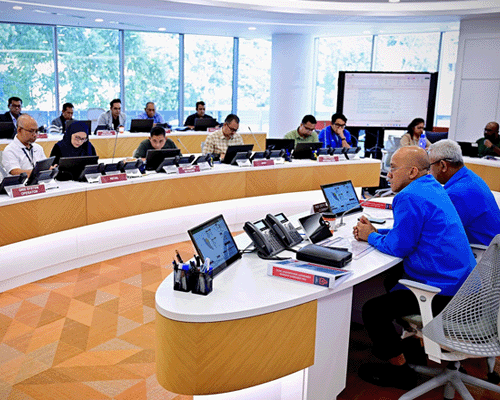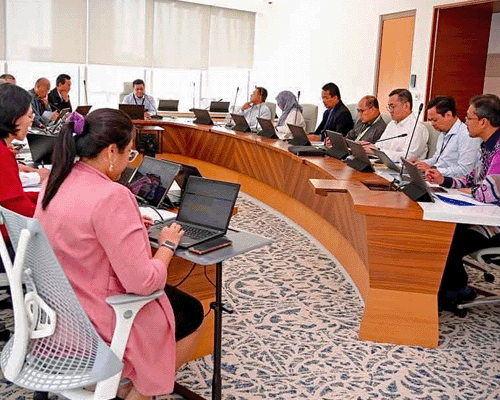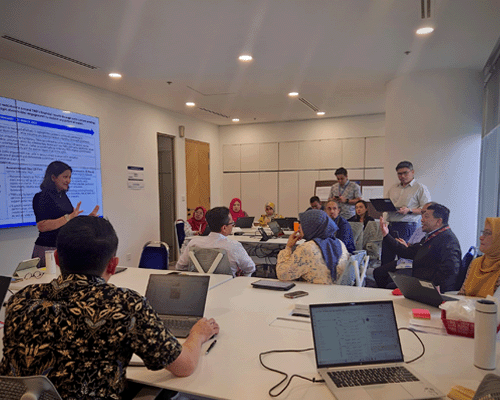In today’s interconnected and rapidly changing world, organisations face a wide range of potential emergencies that often emerge with little to no warning. From global pandemics and increasing cyber threats to climate-driven natural disasters and geopolitical instability, the modern environment is marked by its unpredictability and volatility.
At Tenaga Nasional Berhad (TNB), we recognize the critical role we play in powering communities, businesses, and public infrastructure. Our commitment is to maintain a reliable electricity supply during unforeseen circumstances while safeguarding the trust and well-being of those in the community who depend on our uninterrupted service. Our focus is on service recovery during emergencies and maintaining clear communication with both internal and external stakeholders.
To achieve this, a well-structured business continuity plan is essential to ensure the consistency of our services in the face of disruption. We continually review and stress-test our plan to adapt to evolving challenges. In addition, a proactive incident management approach is in place to address incidents before they escalate into major crises. Through regular scanning and continuous monitoring, we ensure effective and efficient recovery efforts, alongside seamless communication to all relevant stakeholders.
Furthermore, our Emergency Response Plan (ERP) is integrated into our overall strategy ensuring that our teams are well-prepared to respond swiftly and efficiently to any emergency, minimizing potential impact on service delivery.
Our Commitment to Crisis Management
The execution of our business continuity plan in TNB Group stems from the TNB Business Continuity Management (BCM) Framework, which is established in accordance with the international standard ISO 22301 “Security and resilience – Business continuity management systems – Requirements” and global practices, and has been updated over the years to enhance organisational preparedness and resiliency.
With this Framework in place, TNB Group undertakes a structured approach towards business continuity with a prompt, coordinated and effective response, ensuring that essential activities continue, with a focus on protecting human life, assets and reputation.
Contained within the TNB Corporate BCM Document, the Framework is a policy that is applicable across TNB and serves as a focal point of reference for its Business Entities.
Leadership and Support
The ultimate responsibility for the overall planning, implementation, training, testing, and maintenance of the BCM Framework and Document lies with the Corporate Crisis Management Team (CMT) which is helmed by our TNB President/Chief Executive Officer (CEO).
With the intent to strengthen preparedness, the TNB Corporate BCM Steering Committee is established to govern the adequacy and effectiveness of the TNB BCM Framework.
Appointed by the TNB President/CEO, the TNB Crisis Commander chairs this committee with members from across the Business Entities in TNB Group and the committee responsible for, among others:
- Aligning BCM implementation with business strategies.
- Communicating roles and responsibilities to assigned parties.
- Committing adequate resources for capability and process enhancements.
- Driving continuous improvement by analysing test and crisis management outcomes.
Responsibility towards effective BCM is cascaded across TNB Group with each business entity tailoring its BCM plan to its respective nature of business. The BCM plan is approved by the head of the business entity, who is responsible for the governance, implementation, and effectiveness of the plan.
Identification of Potential Risks and Impacts to Ensure Appropriate Crisis Response
To ensure appropriate crisis response, potential risks and impacts are identified through a Risk Assessment Process and Business Impact Analysis. The effects of a risk event or disruption on business operations are analysed and mitigations are identified to shorten disruption periods and minimise impact, with the goal of resuming normal operations safely and quickly.
Take for example a risk occurrence in the form of critical equipment failure leading to prolonged electricity supply interruption impacting a significant number of customers. Based on the Business Impact Analysis, a continuity strategy is in place to be carried out before, during and after a crisis, such as (but not limited to) establishing infrastructure and system redundancies, coordinating response and recovery efforts with relevant authorities, and determining improvements through a post-crisis review.
In addition, proactive measures are undertaken to identify and assess potential risks associated with events that could disrupt normal operations. This includes evaluating risks linked to anticipated occurrences, such as the country’s general elections or seasonal weather patterns like heavy rainfall that could lead to flooding during the monsoon season. By leveraging insights from the analysis of past events and integrating forecasted data, we gain a clearer understanding of possible risk exposures and their potential impact.
With this valuable information, TNB is able to take strategic and pre-emptive actions well in advance to mitigate potential disruptions. These proactive steps allow us to strengthen our preparedness, allocate resources effectively, and implement necessary safeguards to ensure a swift response. By anticipating and addressing risks before they escalate into full-blown crises, we can minimise service interruptions and maintain the reliability of our services during critical events.
Preparing and Responding to Crisis
The TNB Corporate BCM Document outlines the types of crises based on the potential impact to customer experience, business operations and employee experience. Examples include power supply disruptions affecting large populations, health emergencies like a pandemic, natural disasters, and disruption of fuel supply for power generation.
Given our geographically dispersed operations throughout Peninsular Malaysia and Sabah, crisis preparedness and response are organised according to severity-defined crisis categories outlined in the TNB Corporate BCM Document.
Category 1
Crisis that impact operations in a State, Zone, Subzone, Power Station or Department level.
Category 2
Crisis that impact operations of a Business Entity.
Category 3 (Most Severe)
Crisis that impact TNB Group.
Under each Category, triggers are defined that act as a guide for the person-in-charge – also known as the Crisis Commander – to activate the necessary BCM strategies as a response, which includes the mobilisation of operation room(s).
Taking the example of a situation of heavy rainfall that has led to floods within a state, the Crisis Commander of operations at the state commands the management of the crisis by implementing prescribed strategies such as safe shutdown of TNB assets in the affected areas for the purpose of public safety and deployment of mobile generators to strategic locations for continuity of electricity supply, especially to temporary relief centres.
A Structured Command Response
A robust crisis command structure with a clear, hierarchical framework for decision-making, communication, and action is essential to ensure coordinated and efficient responses, minimising damage, protecting personnel, and preserving operational continuity.
The TNB Corporate Crisis Command Structure provides the decision-making framework in response to crisis with two distinct teams, the Corporate Crisis Management Team (CMT) and Corporate Crisis Response Team (CRT), in the management of a Category 3 type of crisis.
Under the leadership of the TNB President/CEO, the Corporate CMT manages the strategic aspects of crisis response, encompassing emergency resource deployment and communication with customers and stakeholders. C-suite executives form the Corporate CMT, providing collaborative input for strategic, group-wide crisis management.
The TNB Crisis Commander directs the Corporate CRT, which manages the full spectrum of operational crisis responses, from power generation and grid network stability to the safety and well-being of TNB personnel, customers and the public.
Crisis command structures at the Business Entity, State, Zone, Subzone, Power Station and Department level mirror the TNB Corporate Crisis Command Structure, ensuring coordinated and efficient crisis management.



Communicating With Our Stakeholders
Timely, transparent, and consistent communication during crisis can quell public anxiety, manage misinformation, and demonstrate our commitment in addressing the crisis. Coordinated processes between Business Entities have been established to convey critical information promptly, outlining our response efforts, and acknowledging stakeholder concerns through a structured narrative of accountability and recovery.
Through our official TNB Careline channels in social media and toll-free number, the public and customers reach out to us to report irregularities or emergencies. Regular monitoring of events, including weather patterns, national incidents, and geopolitical events, allows for early detection of potential crises that may disrupt our operations or delivery of services to customers.
In the event of operational disruption or crisis, we communicate with customers through our official TNB Careline Facebook page and press releases. Through established channels, we provide updates on our response and recovery efforts to key stakeholders, such as the Energy Commission and government ministries. At the same time, internal communication is conducted with TNB personnel to maintain message consistency.
Training and Testing for Greater Resiliency
Training and testing are indispensable components in the TNB BCM Framework. Through training, the theoretical plans are transformed into practical capabilities, ensuring TNB can respond swiftly and decisively when faced with adversity. Regular crisis management training sessions are strategically planned to equip personnel with the necessary skills and knowledge to navigate complex scenarios, fostering clear communication, efficient decision-making, and coordinated action.
Annual testing, through simulations and drills, validates the robustness of our BCM and emergency response plans, exposing vulnerabilities and identifying areas for improvement. Drills are deliberately varied, simulating scenarios from minor operational disruptions to large-scale, multi-faceted crisis. This proactive approach cultivates a culture of preparedness to ultimately minimise the impact of crises, safeguarding people and assets.
At TNB, ensuring the uninterrupted supply of power to the public, customers, and stakeholders is prioritised. While we work diligently to maintain smooth operations, disruptions may occur and our BCM strategies and emergency response plan are in place to ensure we are operationally resilient to weather the challenges.
Equally important is maintaining clear and effective communication with all stakeholders. Our com-munication strategy ensures that key updates and critical information are prompted relayed to internal and external parties, allowing stakeholders to stay informed and make necessary decisions.